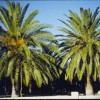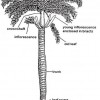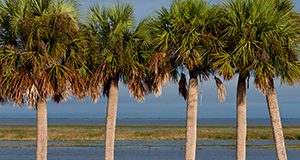Palms growing in Florida landscape or field nurseries are subject to a number of potentially serious nutrient deficiencies. This five-page document discusses the prevention and treatment of these deficiencies. Written by Timothy K. Broschat and published by the Environmental Horticulture Department.
http://edis.ifas.ufl.edu/ep261
Tag: Palms
Phoenix canariensis: Canary Island Date Palm
 The Canary Island date palm is native to the Canary Islands. Although it can reach heights of 40–50 feet, it is slow growing and requires many years to attain that height. It has 8- to 15-foot-long rigid leaves that contain up to 200 V-shaped leaflets, the basal ones of which are modified into long, sharp spines. Leaves are not self-cleaning and must be manually removed when dead, but the leaf bases eventually rot off, leaving an attractive diamond-shaped pattern of leaf scars on the 2- to 3-foot-diameter trunk. On older specimens, the basal foot or so of the trunk typically is covered with short root initials. This 6-page fact sheet was written by T. K. Broschat, and published by the UF Department of Environmental Horticulture, August 2013.
The Canary Island date palm is native to the Canary Islands. Although it can reach heights of 40–50 feet, it is slow growing and requires many years to attain that height. It has 8- to 15-foot-long rigid leaves that contain up to 200 V-shaped leaflets, the basal ones of which are modified into long, sharp spines. Leaves are not self-cleaning and must be manually removed when dead, but the leaf bases eventually rot off, leaving an attractive diamond-shaped pattern of leaf scars on the 2- to 3-foot-diameter trunk. On older specimens, the basal foot or so of the trunk typically is covered with short root initials. This 6-page fact sheet was written by T. K. Broschat, and published by the UF Department of Environmental Horticulture, August 2013.
http://edis.ifas.ufl.edu/st439
Palm Morphology and Anatomy
 Palms differ greatly from broadleaf (dicot) and coniferous (Gymnosperm) trees in their overall form and external structure (morphology) and in their internal structure (anatomy). Morphology and anatomy determine how palms grow, function, and respond to external and internal stress factors. This publication provides a basic understanding of how palms are constructed. This 4-page fact sheet was written by T. K. Broschat, and published by the UF Department of Environmental Horticulture, May2013.
Palms differ greatly from broadleaf (dicot) and coniferous (Gymnosperm) trees in their overall form and external structure (morphology) and in their internal structure (anatomy). Morphology and anatomy determine how palms grow, function, and respond to external and internal stress factors. This publication provides a basic understanding of how palms are constructed. This 4-page fact sheet was written by T. K. Broschat, and published by the UF Department of Environmental Horticulture, May2013.
http://edis.ifas.ufl.edu/ep473
ENH92/MG318 Cold Damage on Palms
Revised! ENH921, a 6-page illustrated fact sheet by Timothy K. Broschat, describes how cold temperatures affect palms and how to treat them following a cold weather event. Includes references. Published by the UF Department of Environmental Horticulture, September 2010.
http://edis.ifas.ufl.edu/mg318
CIR1047/EP001 Transplanting Palms in the Landscape
Revised! Circular 1047, a 9-page illustrated fact sheet by Timothy K. Broschat, discusses the various factors that contribute to palm transplant survival rate. Published by the UF Department of Environmental Horticulture, June 2009.
http://edis.ifas.ufl.edu/EP001
